The Motorola Moto G4 and G4 Plus Review
by Brandon Chester on August 15, 2016 8:00 AM EST- Posted in
- Smartphones
- Lenovo
- Motorola
- Moto G
- Moto G4
GPU Performance
As I mentioned on the last page, moving from Snapdragon 410 to Snapdragon 617 doesn't really lead to a significant improvement in real-world CPU performance. What does improve is GPU performance, which is something that has always been a bit of a problem on low-end and mid-range smartphones. The 2015 Moto G used Qualcomm's Snapdragon 410 SoC. Snapdragon 410 uses Qualcomm's Adreno 306 GPU, which put the 2015 Moto G in a bit of an odd position because that same SoC was used in the significantly cheaper Moto E. Snapdragon 617 uses Adreno 405, which we've demonstrated as providing significantly faster performance than Adreno 306 in past reviews of other devices that use it. It's worth testing a device to ensure everything is working correctly even if you already have results for another device with the same SoC, and so I've run our 2016 GPU benchmarks on the Moto G4.
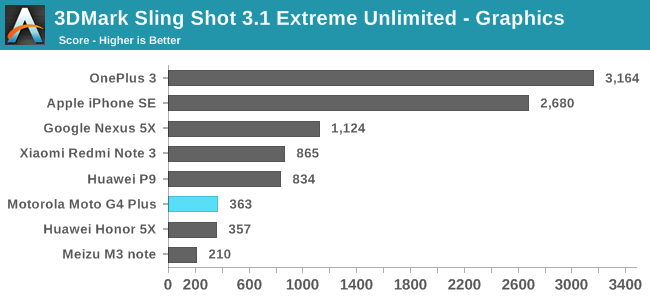
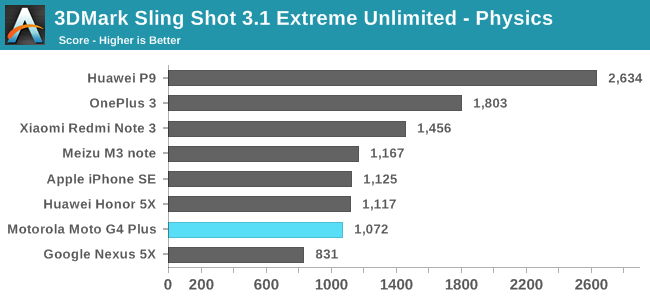
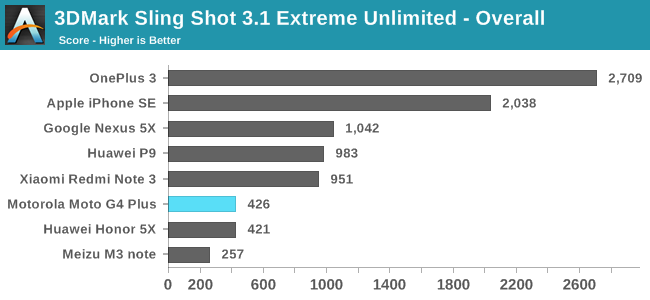
The 2015 Moto G doesn't support OpenGL ES 3.1, and so there's no way to run 3DMark Sling Shot Extreme Unlimited which uses ES 3.1 on Android and Metal on iOS. Snapdragon 617 uses the same Adreno 405 GPU as Snapdragon 615, and you can see in the results that the performance is right in line with the Huawei Honor 5X which uses Snapdragon 615. For a mid-range phone this is generally good performance, but once again the Xiaomi Redmi Note 3 sits far ahead of the rest of the mid-range smartphones, including the Moto G4.
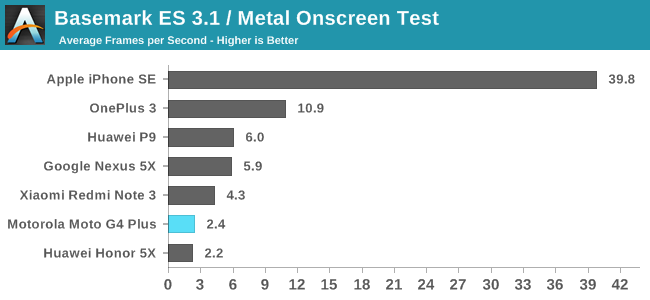
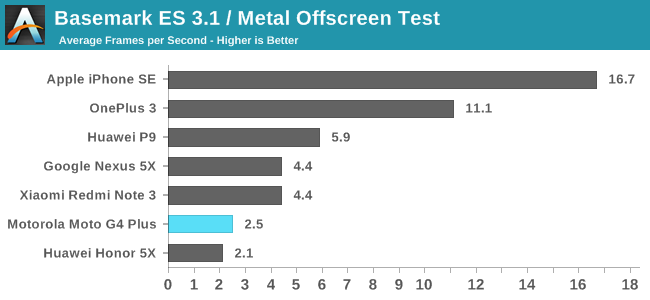
The situation in BaseMark ES 3.1 is the same as 3DMark, with the G4 Plus achieving roughly the same performance as the Huawei Honor 5X. The Xiaomi Redmi Note 3 with its Adreno 510 GPU ends up being a little over 75% faster, which is a huge improvement even if both devices technically don't get close to a playable frame rate in this very heavy test.
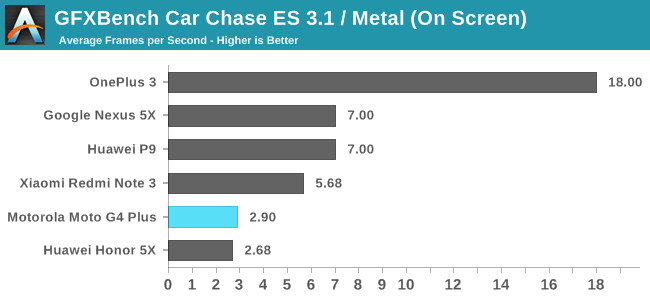
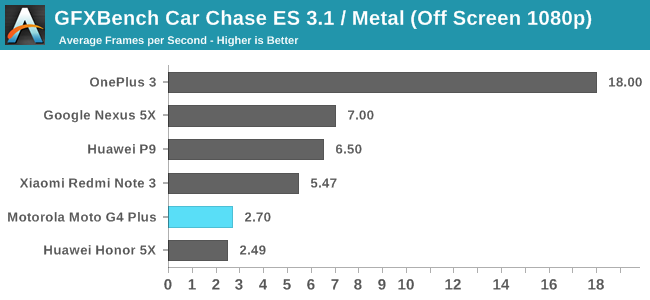
In GFXBench Car Chase it's the story is the same. The Moto G4 Plus is in line with other Adreno 405 devices, but the question is really whether or not that's good enough for a device launching this late into 2016.
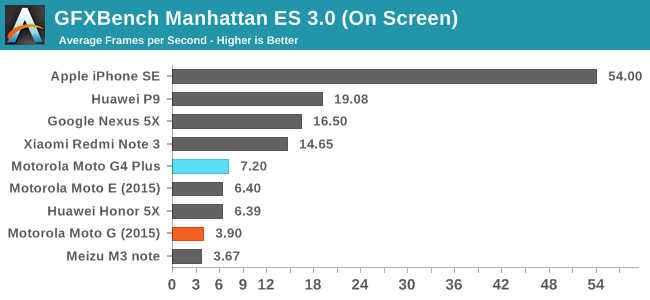
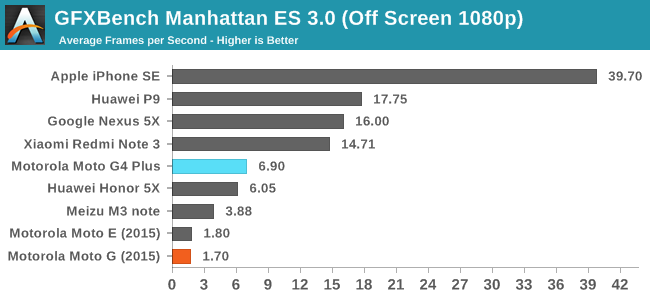
We've generally moved to Manhattan ES 3.1 / Metal for our reviews, but in cases like this where a device's predecessor doesn't support OpenGL ES 3.1 it's helpful to bring back Manhattan ES 3.0 to do a direct performance comparison. As expected, the Moto G4 is much faster than the 2015 Moto G, with on screen performance being about 85% faster despite the move from 720p to 1080p. and off screen performance being over four times faster.
It's clear that the Moto G4 provides much better GPU performance that the 2015 Moto G. However, much like the CPU benchmarks, I keep looking at the charts and seeing the Xiaomi Redmi Note 3 sitting well above the Moto G4. Adreno 405 is much better than Adreno 306, but Adreno 510 is two times faster than Adreno 405. I feel like the Moto G4 is simply launching too late for this kind of performance to be competitive, as it's tied with the Honor 5X which was launched at $200 nearly a year ago. While I don't mean to take away from the fact that the Moto G4 does provide faster GPU performance than its predecessor, I think there are devices right around the corner that are going to make a mid-range smartphone with Snapdragon 617 look decidedly last generation.
NAND Performance
NAND performance is still an area of concern on mid-range smartphones, but the situation has gotten better in recent times. The 2015 Moto E was an example of a device with very poor NAND performance, but the 2015 Moto G was significantly faster across the board. Motorola is still using eMMC memory, but there's definitely room for improvement over the 2015 Moto G even when sticking with an eMMC storage solution. To evaluate the Moto G4's storage performance I've run AndroBench 4.0 on both the 16GB Moto G4 and the 64GB Moto G4 Plus.
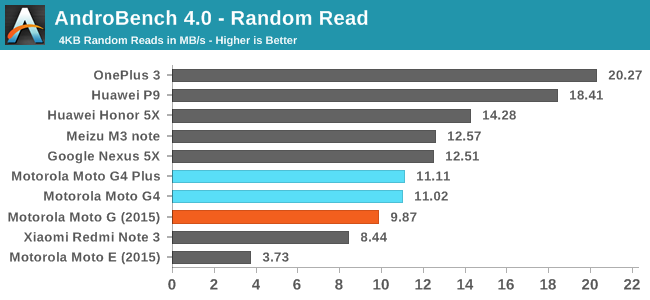
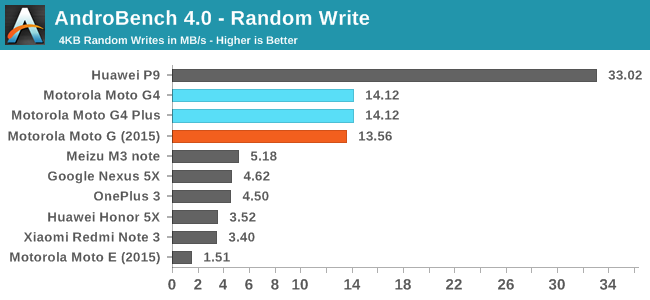
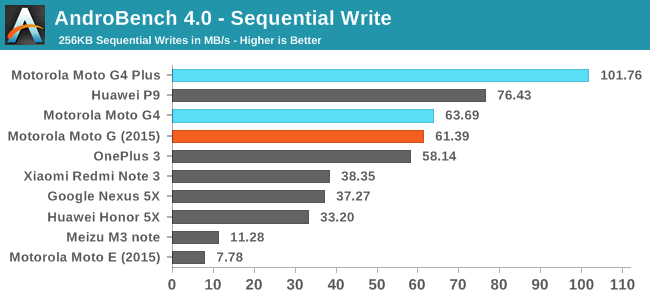

Among mid-range devices, the 64GB Moto G4 Plus performs very well. Random write results are ahead of all other devices on the chart except the Huawei P9, which isn't really a mid-range device and is just there for SoC comparisons. In the sequential write test the Moto G4 leads, which is due in part to the larger capacity allowing greater write parallelism. Sequential read performance is very good as well, although obviously not competitive with UFS 2.0 storage solutions like the one used in the OnePlus 3.










94 Comments
View All Comments
Cod3rror - Monday, August 15, 2016 - link
It does have a gyroscope, but this time it does not have a magnetometer (G3 has magnetometer but no gyroscope), so you're not going to be able to use compass applications.Rrskda - Monday, August 15, 2016 - link
How important is the magnetometer? From what Google tells me, it's the least useful of the three (including accelerometer, gyroscope).Cod3rror - Monday, August 15, 2016 - link
How important is it for you for the map to rotate smoothly when you turn your phone?Meteor2 - Sunday, September 11, 2016 - link
Maps should always have north at the top.raju516 - Monday, August 15, 2016 - link
The poor performance is due to the 617 chip not firmware as i see no phone with 615,617 that performs well atleast day to day tasks. Many reviewers while revieiwnfg phones with 615, 617 attribute the poor perfromance, stuttering to firmware which is not the case. The 615,617 overheats easily and are worst processors till date.cbm80 - Monday, August 15, 2016 - link
They embiggened it and made it cromulent, but they failed to make it performant!Atakelane - Monday, August 15, 2016 - link
"Choosing an eight core Cortex A53 SoC to appeal to the Chinese market instead of a six core Snapdragon 650 was not a good decision for the user experience.". What an irony. The Chinese Xiaomi uses the SD650. I, think Moto got their strategy all wrong for the Chinese as well as global market.Coming to the overheating issues, Moto seems to have hit a bump with the SD6XX series cpu's. Even the Moto G3 Turbo, with SD615 has terrible heat issues. The normal G3 on the other hand extracted the best possible performance from the SD410.
So, why does a cpu that performs well in phones like Asus Zenfone Selfie and LG G4s, fare poorly in all Moto phones (G4, G3 Turbo, Moto X Play) ? Weird. Where is it, that Moto going wrong? Has Lenovo something to do with it, as all the problematic phones were launched after Lenovo acquired Moto?
vLsL2VnDmWjoTByaVLxb - Monday, August 15, 2016 - link
Typo, Page 6:want to look *onn* the bright side, it lets you know when your phone is done charging,
Brandon Chester - Monday, August 15, 2016 - link
Good catch. Thanks.junky77 - Monday, August 15, 2016 - link
There is another factor that should be considered - previous generation 'premium' smartphones are now selling for $230-$250 (Nexus 5X) and are probably better than these by a lot, overall. So, why get the Moto G Plus instead of the 5X?